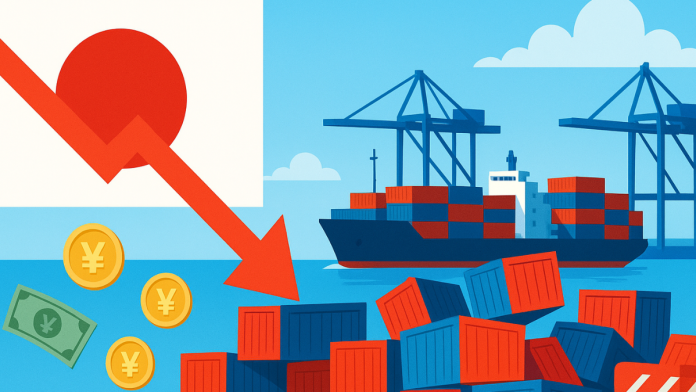Japan’s economy recorded its first contraction in six quarters during the July–September period. Government data released on Monday showed that the country’s gross domestic product fell by 1.8%. This drop came after a revised 2.3% growth in the previous quarter.
The slowdown began when new U.S. tariffs on Japanese goods came into effect. Japan sends many products abroad, and exports are a major driver of its growth. When the United States raised tariffs, Japanese companies immediately felt the pressure. This made the three-month period one of the most challenging since early last year.
This contraction was smaller than the 2.5% decline predicted in a poll. But it was still a major shift from Japan’s earlier growth trend. The data also showed a 0.4% decline in the quarter-to-quarter comparison, against a forecast of 0.6%.
Exports decline sharply under new tariff rules
Exports played the biggest role in the economic downturn. The fall began after the United States and Japan formalised a trade agreement in September. Under the deal, nearly all Japanese imports into the U.S. now face a baseline 15% tariff. Before the agreement, the U.S. imposed 27.5% tariffs on autos and 25% on most other goods.
This shift caused a noticeable drop in Japan’s outbound shipments. Automakers experienced the steepest decline. Before the tariffs took effect, they increased exports to get ahead of the price changes. Once the tariff rules formally started, shipments fell sharply. Car companies also chose to absorb some tariff costs by lowering prices, which affected revenue.
Net external demand, which is exports minus imports, reduced growth by 0.2 percentage points. In the previous April–June quarter, it had added the same amount. This change marked a clear reversal in how global demand contributed to Japan’s economy.
The export decline also affected overall production lines. Fewer orders meant slower factory activity, especially in sectors linked to automobiles. This had a direct impact on the national GDP figures for the July–September period.
Tokyo takes a stand — Defense Minister hints at harder sanctions on Russia as peace talks stall
Mixed performance in domestic consumption and investment
Domestic activity showed a mixed pattern. Private consumption, which makes up more than half of Japan’s economic output, grew by 0.1%. This matched market expectations but was slower than the 0.4% growth recorded in the April–June quarter. Higher food prices made households more cautious about spending, especially on non-essential items.
Housing investment fell during the period. In April, new rules on energy-efficiency standards were introduced. These rules made construction planning more complex, slowing down commitments and reducing housing-related spending across the quarter.
On the other hand, capital spending rose by 1.0%, well above the forecast of 0.3%. This indicated that many businesses continued to invest in equipment and facilities, even as exports weakened. According to government officials, private consumption has now risen for six straight quarters, while capital spending has grown for four.
Government stimulus plans take shape
The GDP numbers were released while policymakers were discussing major economic support steps. The data influenced views on interest-rate decisions, especially for the upcoming Bank of Japan meeting. Some economists said that raising interest rates in December would be difficult to justify with the economy showing signs of strain.
At the same time, the government continued preparing a large stimulus package. Officials have been working on measures to help households manage rising living costs. Media reports stated that the planned package would be above 17 trillion yen, making it one of the significant steps announced in recent months.
The package is expected to support household income conditions starting late winter and into spring. Measures will focus on easing cost burdens, especially as prices remain high for many essential goods.
The latest economic data came as the administration worked to balance trade pressures, consumer challenges, and domestic spending levels. The July–September contraction provided a clearer picture of how tariffs and new regulations shaped the economy in this period.


